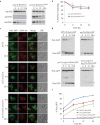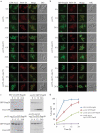The autophagic degradation of cytosolic pools of peroxisomal proteins by a new selective pathway
- PMID: 31007124
- PMCID: PMC6984484
- DOI: 10.1080/15548627.2019.1603546
The autophagic degradation of cytosolic pools of peroxisomal proteins by a new selective pathway
Abstract
Damaged or redundant peroxisomes and their luminal cargoes are removed by pexophagy, a selective autophagy pathway. In yeasts, pexophagy depends mostly on the pexophagy receptors, such as Atg30 for Pichia pastoris and Atg36 for Saccharomyces cerevisiae, the autophagy scaffold proteins, Atg11 and Atg17, and the core autophagy machinery. In P. pastoris, the receptors for peroxisomal matrix proteins containing peroxisomal targeting signals (PTSs) include the PTS1 receptor, Pex5, and the PTS2 receptor and co-receptor, Pex7 and Pex20, respectively. These shuttling receptors are predominantly cytosolic and only partially peroxisomal. It remains unresolved as to whether, when and how the cytosolic pools of peroxisomal receptors, as well as the peroxisomal matrix proteins, are degraded under pexophagy conditions. These cytosolic pools exist both in normal and mutant cells impaired in peroxisome biogenesis. We report here that Pex5 and Pex7, but not Pex20, are degraded by an Atg30-independent, selective autophagy pathway. To enter this selective autophagy pathway, Pex7 required its major PTS2 cargo, Pot1. Similarly, the degradation of Pex5 was inhibited in cells missing abundant PTS1 cargoes, such as alcohol oxidases and Fox2 (hydratase-dehydrogenase-epimerase). Furthermore, in cells deficient in PTS receptors, the cytosolic pools of peroxisomal matrix proteins, such as Pot1 and Fox2, were also removed by Atg30-independent, selective autophagy, under pexophagy conditions. In summary, the cytosolic pools of PTS receptors and their cargoes are degraded via a pexophagy-independent, selective autophagy pathway under pexophagy conditions. These autophagy pathways likely protect cells from futile enzymatic reactions that could potentially cause the accumulation of toxic cytosolic products.Abbreviations: ATG: autophagy related; Cvt: cytoplasm to vacuole targeting; Fox2: hydratase-dehydrogenase-epimerase; PAGE: polyacrylamide gel electrophoresis; Pot1: thiolase; PMP: peroxisomal membrane protein; Pgk1: 3-phosphoglycerate kinase; PTS: peroxisomal targeting signal; RADAR: receptor accumulation and degradation in the absence of recycling; RING: really interesting new gene; SDS: sodium dodecyl sulphate; TCA, trichloroacetic acid; Ub: ubiquitin; UPS: ubiquitin-proteasome system Vid: vacuole import and degradation.
Keywords: Autophagy; PTS receptors; peroxisomal matrix proteins; peroxisome; pexophagy receptor.
Figures







Similar articles
-
The unique degradation pathway of the PTS2 receptor, Pex7, is dependent on the PTS receptor/coreceptor, Pex5 and Pex20.Mol Biol Cell. 2014 Sep 1;25(17):2634-43. doi: 10.1091/mbc.E13-12-0716. Epub 2014 Jul 9. Mol Biol Cell. 2014. PMID: 25009284 Free PMC article.
-
Atg36: the Saccharomyces cerevisiae receptor for pexophagy.Autophagy. 2012 Nov;8(11):1680-1. doi: 10.4161/auto.21485. Epub 2012 Aug 9. Autophagy. 2012. PMID: 22874561 Free PMC article.
-
Pex3-anchored Atg36 tags peroxisomes for degradation in Saccharomyces cerevisiae.EMBO J. 2012 Jun 29;31(13):2852-68. doi: 10.1038/emboj.2012.151. Epub 2012 May 29. EMBO J. 2012. PMID: 22643220 Free PMC article.
-
Pexophagy in yeasts.Biochim Biophys Acta. 2016 May;1863(5):992-8. doi: 10.1016/j.bbamcr.2015.09.023. Epub 2015 Sep 26. Biochim Biophys Acta. 2016. PMID: 26409485 Review.
-
Role of PEX5 ubiquitination in maintaining peroxisome dynamics and homeostasis.Cell Cycle. 2017;16(21):2037-2045. doi: 10.1080/15384101.2017.1376149. Epub 2017 Sep 21. Cell Cycle. 2017. PMID: 28933989 Free PMC article. Review.
Cited by
-
Autophagy: A Key Player in Pancreatic Cancer Progression and a Potential Drug Target.Cancers (Basel). 2022 Jul 20;14(14):3528. doi: 10.3390/cancers14143528. Cancers (Basel). 2022. PMID: 35884592 Free PMC article. Review.
-
Anti-Aging Effects of R-Phycocyanin from Porphyra haitanensis on HUVEC Cells and Drosophila melanogaster.Mar Drugs. 2022 Jul 22;20(8):468. doi: 10.3390/md20080468. Mar Drugs. 2022. PMID: 35892936 Free PMC article.
-
Fasudil prevents neomycin-induced hair cell damage by inhibiting autophagy through the miR-489/NDP52 signaling pathway in HEI-OC1 cells.Exp Ther Med. 2022 Jan;23(1):43. doi: 10.3892/etm.2021.10965. Epub 2021 Nov 12. Exp Ther Med. 2022. PMID: 34849158 Free PMC article.
-
Mitochondrial and Organellar Crosstalk in Parkinson's Disease.ASN Neuro. 2021 Jan-Dec;13:17590914211028364. doi: 10.1177/17590914211028364. ASN Neuro. 2021. PMID: 34304614 Free PMC article.
-
Pre-meiotic deletion of PEX5 causes spermatogenesis failure and infertility in mice.Cell Prolif. 2023 Mar;56(3):e13365. doi: 10.1111/cpr.13365. Epub 2022 Nov 26. Cell Prolif. 2023. PMID: 36433756 Free PMC article.
References
Publication types
MeSH terms
Substances
Grants and funding
LinkOut - more resources
Full Text Sources
Other Literature Sources
Miscellaneous
